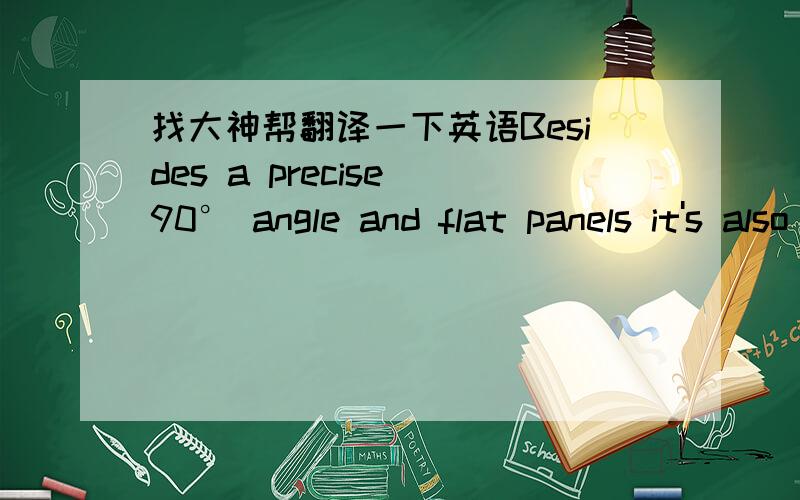找大神帮翻译一下英语Besides a precise 90° angle and flat panels it's also important that the applied patterns are not fixed rotated and a possible offset towards the expected corner's edge is set according to the corner's reality. How does
来源:学生作业帮助网 编辑:作业帮 时间:2024/04/28 06:37:06

找大神帮翻译一下英语Besides a precise 90° angle and flat panels it's also important that the applied patterns are not fixed rotated and a possible offset towards the expected corner's edge is set according to the corner's reality. How does
找大神帮翻译一下英语
Besides a precise 90° angle and flat panels it's also important that the applied patterns are not fixed rotated and a possible offset towards the expected corner's edge is set according to the corner's reality. How does a corner scan looks like if you compare it to the virtual corner?
could be caused by several things:
A: Your partial scans are somehow distorted. Possible reasons:
- The cam/projector ratio changed after calibration. Even if you did not touch your rig it may happen that during a session the temperature of the cam and/or projector rises. This may cause some minimal physical changes in the devices. Try to calibrate your system being warm (means already running some minutes).
- Against all your efforts your corner may still owns some errors. Besides a precise 90° angle and flat panels it's also important that the applied patterns are not fixed rotated and a possible offset towards the expected corner's edge is set according to the corner's reality. How does a corner scan looks like if you compare it to the virtual corner?
If you did these scans with the same settings as posted in the bug section:
You may try these advanced settings:
"CompensatePatternRotInPlane" value="True" (I never could get a pattern applied without any rotation. Here ithe left plane is rotated about 0,6°)
"ExpectedPlaneOffsetsOfOuterCorner" value="yourValue" (it it should be: (measured distance between the markers' centers next to the edge and the edge)-Scale/8 )
- For you use a modified webcam: maybe your optics aren't ideal? (you may try optics made for a bigger sensor)
B: alignment issues:
- Your basic alignment strategy shoul be to align following topology quality. Means: Align the partial scans with dominant topology first (group these results) and closed the final gab with the partial scan with poorest topology.
- If you restrict alignment to a certain axis, make shure that your rotation device actually rotates around this (or a parallel) axis. I use such restriction only in very few cases when not-restricted alignment has to fail (e.g scanning a sphere). In most cases I can trust DAVID running free.
- You may try to increase the number of pointpairs and iterations for global registration.
AdvancedSettings/Shapefusion/GlobalFineRegistration/PointPairsPerScan and Iterations (note: this will need more time and resources to process a global registration)
找大神帮翻译一下英语Besides a precise 90° angle and flat panels it's also important that the applied patterns are not fixed rotated and a possible offset towards the expected corner's edge is set according to the corner's reality. How does
除了精确的90°角和平面显示器也是很重要的应用模式是不固定的旋转和一个可能的实现的预期角落的边缘偏移量是根据转角的实际设置.如何做一个角落扫描查找,如果你把它比作虚拟角样的?
可能的原因包括几件事情:
答:你的部分扫描在某种程度上扭曲.可能的原因:
- 校准后的凸轮/投影机比改变.即使你没有碰到你的装备可能发生在会话过程中的凸轮和/或投影机的温度上升.这可能会导致在器件的一些最小的物理变化.尝试校准你的系统是温暖的(手段已经运行了几分钟) .
- 对你的努力你的角落可能仍然拥有一些错误.除了精确的90°角和平面显示器也是很重要的应用模式是不固定的旋转和一个可能的实现的预期角落的边缘偏移量是根据转角的实际设置.如何做一个角落扫描查找,如果你把它比作虚拟角样的?
如果你没有这些扫描与作为张贴在错误部分相同的设置:
您可以尝试以下高级设置:
“ CompensatePatternRotInPlane ”值= “真” (我无法让自己的模式应用于无任何转动.这里i将离开平面旋转约0.6 ° )
“ ExpectedPlaneOffsetsOfOuterCorner ”值= “ yourValue ” (它应该是:(标记'中心之间旁边的边缘和边缘)量程/ 8测量的距离)
- 对于您使用修改后的摄像头:也许你光学不理想?(你可以尝试一个更大的传感器制造光学)
B:对齐问题:
- 你的基本路线的策略建议立即进行删除是对准下面的拓扑结构的质量.意思是:对准占主导地位的拓扑结构第一(组这些结果)的部分扫描并与最贫穷的拓扑结构的部分扫描关闭的最后瞎扯.
- 如果您限制对齐到一定的轴,使舒尔您旋转装置解决这个实际转动(或平行)轴.我只在极少数情况下才使用这样的限制时,不限制对齐有失败(例如扫描球体).在大多数情况下,我可以信任DAVID运行免费的.
- 你可以试着加大pointpairs和迭代的全球注册人数.
AdvancedSettings/ Shapefusion/ GlobalFineRegistration/ PointPairsPerScan和迭代(注:这将需要更多的时间和资源来处理全球注册)
除了一个精确的90°角和平板也很重要,应用模式不是固定的旋转和可能抵消对预期的角落的边缘设置根据角落的现实。如何一个角落扫描看起来就像如果你比较虚拟的角落吗?可能造成的几件事:你的部分扫描是扭曲的。可能的原因:- cam /投影仪率校准后改变了。即使你没有触摸你的平台可能发生在一个会话凸轮和/或投影仪的温度上升。这可能会导致一些最小的物理变化的设备。试着调整你的系统被温暖的(意味着已经运行几分钟)...
全部展开
除了一个精确的90°角和平板也很重要,应用模式不是固定的旋转和可能抵消对预期的角落的边缘设置根据角落的现实。如何一个角落扫描看起来就像如果你比较虚拟的角落吗?可能造成的几件事:你的部分扫描是扭曲的。可能的原因:- cam /投影仪率校准后改变了。即使你没有触摸你的平台可能发生在一个会话凸轮和/或投影仪的温度上升。这可能会导致一些最小的物理变化的设备。试着调整你的系统被温暖的(意味着已经运行几分钟)。——对所有你的努力你的角落可能仍然拥有一些错误。除了一个精确的90°角和平板也很重要,应用模式不是固定的旋转和可能抵消对预期的角落的边缘设置根据角落的现实。如何一个角落扫描看起来就像如果你比较虚拟的角落吗?如果你做了这些相同的扫描设置发布错误部分:你可以试试这些高级设置:“CompensatePatternRotInPlane”价值= " True "(我从来没有可以应用模式没有任何旋转。这里是不是左平面旋转约0,6°)值=“ExpectedPlaneOffsetsOfOuterCorner yourValue”(它应该是:(测量标记之间的距离的中心旁边的边缘和边缘)剂量/ 8),你使用一个修改摄像头:也许你的光学不理想?(你可能尝试光学为一个更大的传感器)B:对齐问题:——你的基本一致性的策略应该是一致拓扑的质量。意思是:使局部扫描与占主导地位的拓扑(这些结果组)和关闭最后多嘴部分扫描与贫穷的拓扑。——如果你限制在一定轴对齐,使美国舒尔,实际上你的旋转设备(或平行)轴旋转。我使用这些限制只在很少的情况下当not-restricted对齐失败(e。g扫描一个球体)。在大多数情况下我可以相信大卫运行免费的。——你可能试图增加pointpairs和迭代的数量在全球注册。AdvancedSettings / Shapefusion / GlobalFineRegistration / PointPairsPerScan和迭代(注意:这将需要更多的时间和资源来处理全球注册)
收起
呵呵,这种貌似需要你很精确理解的东西,不花钱找对口的有三年以上同行业翻译经验的公司翻译的话,你就用二楼的凑合看吧。
如果你敢的话。